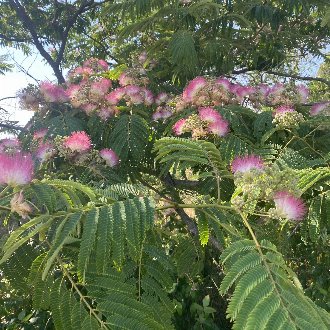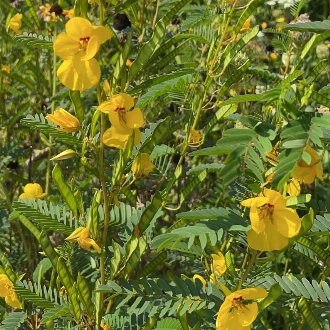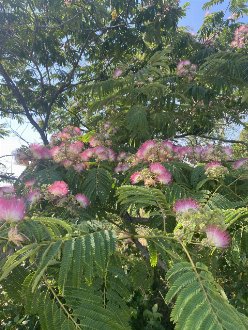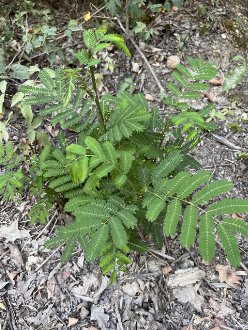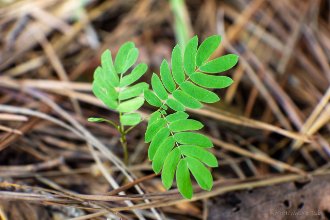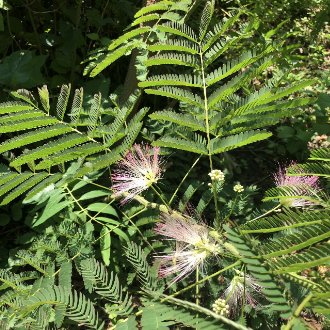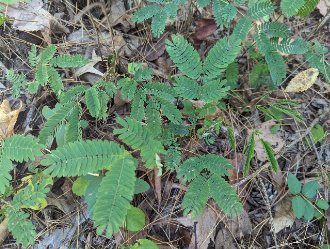Persian Silktree (Albizia julibrissin Durazz.)
Also known as mimosa, Persian silk tree, pink silk tree.
↑Summary
A small nitrogen-fixing tree native to the warmer parts of Asia. and planted as an ornamental in the US, where it has become invasive.
↑Range - Expand
| Legend | Color |
| Introduced | |
| Introduced or Not Present |
This map is based on our research. We have checked its accuracy to Level 3 ecoregions. Although this plant occurs somewhere in each of these regions, it may only occur in a small part of some or all of them.
Although POWO does not report this species occurring in Mexico, it is definitely planted there in landscaping and it seems unlikely that it has not established in the wild at least somewhere in Mexico; we have yet to research this question.
↑Similar Plants
↑Habitat
This species has been introduced throughout the southern US and extending slightly into the northeast, but it is more common in the southeast. Its habitat preferences vary by region and are not well-understood, but it is more common in disturbed, anthropogenic habitats such as along roadsides, railroads, in abandoned fields, urban areas, and occasionally in suburban gardens and parks. Especially in the southeast, it has also invaded wild ecosystems including oak-hickory, pine, and oak-hickory-pine forest, openings in riparian forests, and grasslands. In woodlands it is restricted to gaps, edges, and locally-disturbed sites. In California it is most often found on oak-dominated foothills. Its survival in the north of its range is likely limited by its poor cold tolerance, and in these areas it is more common on sheltered sites and in cities where it benefits from urban heat island effect.
It is a pioneer species that is mostly intolerant of shade; it can sometimes persist temporarily into mid-successional stages of a site but declines as the canopy closes. In a broader region its populations decline as forest cover increases.
It tolerates a wide range of moisture conditions, growing both on dry sites and on wetland margins and in floodplains; it is occasional on mesic sites but often less common and does not persist as long, as mesic sites are more likely to support (or more quickly develop into) closed-canopy forest. It often grows best on bottomland sites that are unusually drought-prone, such as elevated areas of sandy or rocky soils within bottomlands, or gravel bars or sandbars in areas that experience deep drops in the water level during the growing season.
It also tolerates a wide variety of soil conditions. It prefers soils low in nitrogen, as it is a nitrogen fixer. It is mostly indifferent to soil pH, tolerating alkaline soils more than most plants that grow in the southeast, and it can also grow on acidic soils. We could not find a pH range for wild plants but gardening sites give the unusually broad range of 3.5-8.5 which is consistent with records of it in the wild. It can occur on a wide range of soil textures, including sandy, rocky, loamy, and clayey soils, but it prefers coarse-textured, better-draining soils. It may prefer soils lower in organic matter, as organic matter accumulation tends to favor competing vegetation as well as the fungus that often leads to its decline.
Its fire ecology is not well-known but it seems able to thrive in, and may prefer habitats that experience periodic fire, but it prefers habitats that have severe fires less often than stable longleaf pine (Pinus palustris) savannas, and it tends to move into these savannas in the absence of fire. Because of its thin bark it tends to be top-killed by high-intensity fire, but it can resprout, and it also tends to colonize recently-burned sites.
↑Life Cycle
In North America, Albizia julibrissin grows as a small, short-lived tree that rapidly colonizes open sites and can spread aggressively, but rarely persists on a site very long.
Healthy plants resprout vigorously if top-killed, which can occur both due to fire and cutting.
We could not find information on the age to flowering and seed production in the wild, but it is likely similar to garden plants, which often produce a few blooms as young as 3-5 years. Flower and seed production peaks later, typically closer to 10-20 years of age and continues until trees decline. Plants are self-incompatible, requiring cross-pollination to produce viable seed. We could not find any information on whether or not this species produces more seed in some years; closely-related legume trees include examples of species with consistent seed production as well as others that alternate good seed crops with years of low production.
Seeds are distributed by wind, with water, animals, and humans also providing significant roles. The broad, lightweight ponds can be blown significant distances in high wind. Water is especially important for dispersing seeds when this species grows in bottomlands. Humans tend to aid the spread of this species by moving dirt for fill; seeds present in the fill often germinate in response to the sunny, open, disturbed conditions following the installation of new fill.
Plants form a long-term seed bank and often will not germinate until conditions are right for establishment. The exact duration of persistence is unknown; a small portion of seeds kept in artificial conditions have been recorded germinating after as long as 70-150 years, but it is likely that few seeds could persist this long in the wild. It is likely that in the wild, seeds persist for shorter periods of more like 5-7 years, with perhaps a small number of seeds persisting longer.
Death usually occurs by the fungus Fusarium oxysporum, which is more prevalent in North America than in this species' native range. Trees live an average of about 30 years and it is common for trees to die after only 10-20 years.
↑Faunal Associations
Livestock including sheep, goats, and possibly other animals occasionally browse on the foliage, but do not prefer it. Native mammalian herbivores favor it even less. It can be used as cover by wildlife in sunny habitats where its foliage is denser. The flowers are visited by hummingbirds, honeybees, bumblebees, and various butterflies.
This species is eaten by a mix of native and introduced insects, most of which are semi-specialists on legumes, and some of which are more generalist and also eat a number of commercial crops.
The plant sap is eaten by the introduced pea aphid Acyrthosiphon pisum, which eats many legumes. The leaves are eaten by the larvae of the introduced mimosa webworm (Homadaula anisocentra), which also eats the native honeylocust (Gleditsia triacanthos). It is also eaten by the Reakart's blue (Hemiargus isola), a primarily tropical butterfly which also eats other legumes. The leaf beetle Bruchidius terrenus, introduced from Asia, also eats the foliage. The grape mealybug (Pseudococcus maritimus), a scale insect which prefers eating grapes (Vitis sp.), also has been recorded eating this plant. Another scale insect with a different preferred host, the winged euonymus scale (Lepidosaphes yanagicola), also eats this plant.
↑Control
Albizia julibrissin can be either easy or difficult to control, depending on the site's conditions and history and people's ability to coordinate control efforts across multiple properties.
This species is easiest to remove where it is already in decline due to shading and soil accumulation. On richer, moister sites with less sunlight, individual trees can be removed and other trees can be allowed to fill in, which will usually shut this species out, preventing it from returning.
The greatest risk of this species' establishment happens in the early successional stage of habitats, such as following logging, clearing of land, laying of fill, or the abandoning of agriculture or conversion of any open habitat into forest. The most efficient method of preventing this species from establishing is to remove all nearby adult trees in the 5-10 years prior to a clearing of a site, so as to reduce the prevalence of seeds in the seed bank. This is often less labor-intensive than trying to remove a large number of seedlings or saplings in early-successional habitat.
Once this species seeds into a site, small seedlings up to about 2 feet in height can be uprooted by hand, and slightly larger ones with tools. Care must be taken to remove the entire root; plants can easily break off above the root crown and then will resprout. Larger trees can be cut, and if they are growing in with competing vegetation, other trees may overtop this species and shade it out even if it resprouts. However in monocultures and where there is less competing vegetation, more work may be necessary to ensure other trees establish. The seeding in of native legumes, both woody and herbaceous, may help prevent this species' establishment both through direct competition and through adding nitrogen to the soil and removing this species' key advantage.
We recommend caution with controlled burns in areas where this species is already established or is present in the seed bank, as it often benefits from fire.
We recommend against herbicide as an initial control option for this species; it tends to have a lower leaf-surface-area-to-root-volume ratio than most competing woody plants in the habitats where it occurs, and as such, herbicide application sufficient to kill it often causes great harm to nontarget vegetation, which can lead this plant to recolonize or even increase in extent. A more effective approach is to cut trees and use herbicide for stump treatments, or to use more targeted application to the foliage of resprouts only, thus hitting a smaller area of leaf when the plant has already been weakened.
Another risk to consider with this species is that it tends to thrive and spread along roadsides, railroad tracks, and maintained forest edges, where it benefits from the repeated clearing of vegetation from the edge creating the high-light conditions it enjoys. It also benefits from gravel and sand of a roadbed or railroad bed creating more nitrogen-poor and drought-prone conditions in which it has an advantage. Training the crews who work clearing vegetation and/or spraying herbicide to identify and target adult trees even if they are slightly farther back from the edge, can be helpful to ensure this plant does not spread along these corridors. At the same time, exercising restraint in pruning branches of native trees, allowing them to sweep closer to the ground and close gaps along the edge can also reduce the light penetration to the ground along these edge habitats, which can make it less likely that this plant recolonizes. Seeding native herbaceous vegetation along the edge can also provide ground-level competition for this plant.
It is also important to avoid sourcing fill dirt from an area where this species has grown recently, as it is highly likely to germinate and establish on such dirt.
↑Uses
This species was widely planted in gardens until recently. It was valued for its rapid growth, attractive foliage and form, tolerance of drought and deer. However even in a garden setting it can be short-lived and can be stressed or die from shading, and in the north, winter cold.
It is now widely recognized as invasive, especially in the southeast, and its planting is discouraged and even illegal in some states. We recommend not only avoiding planting it, but removing it where it occurs.
In the past, it was used in restoration plantings on landfills and strip-mining sites. Although it is effective for this purpose, because of its invasive potential, it is better to use any number of native species in its place.
↑Related Plants
Several other Albizia species are also found in North America, all introduced, including the Indian siris (Albizia lebbeck), the indian albizia (Albizia lebbekoides), and the white siris (Albizia procera).
↑Links & External Resources
• Silktree | Fire Effects Information System (FEIS) (About This Site)
• Albizia julibrissin (Persian Silk Tree) | Illinois Wildflowers (About This Site)
• Albizia julibrissin (silktree) | USDA PLANTS Database (About This Site)
• Albizia julibrissin | Go Botany (About This Site)
• Albizia julibrissin (Silk Tree) | Missouri Botanical Garden Plant Finder (About This Site)
• Mimosa | Virginia Tech Dendrology Factsheets (About This Site)
• Albizia julibrissin | Biota of North America Project (BONAP) (About This Site)
• Albizia julibrissin | NatureServe Explorer (About This Site)
• Albizia julibrissin | Missouri Plants (About This Site)
• Silktree | Maryland Biodiversity Project (About This Site)
• Albizia julibrissin Durazz. | Plants of the World Online (POWO) (About This Site)
• Albizia julibrissin Durazz. (Mimosa, Silk Tree) | Digital Atlas of the Virginia Flora (About This Site)



